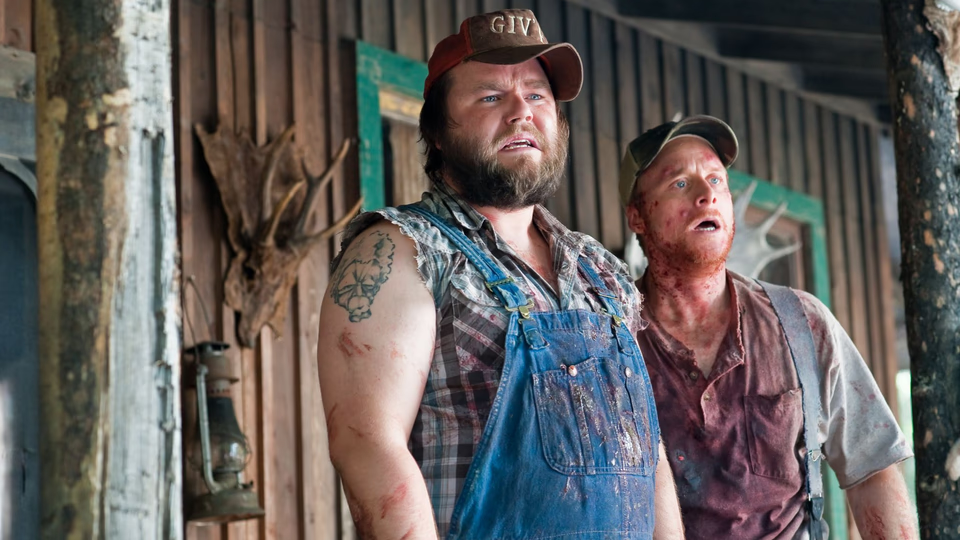Tucker and Dale vs Evil

Alan Tudyk and Tyler Labine play the titular Tucker and Dale, a pair of good-natured hillbillies. They’re visiting their new Appalachian vacation home, a dilapidated cabin right out of a horror film that they’re proud to call their own. But their relaxing weekend of fishing and home renovation goes awry when they cross paths with a group of coeds who mistake them for psychopaths. For the coeds, a series of comical misunderstandings beget horrific misfortunes, while the befuddled Tucker and Dale find themselves surrounded by bodies.
Horror comedy is hard, but for its first two acts, this film makes it look easy. The genius lies how the film places its cast in two separate movies.
The coeds are in a traditional slasher horror film. They encounter menacing mountain folk, witness one of their own being dragged motionless aboard the hillbillies’ boat, and discover their friends’ mutilated corpses.
Meanwhile, Tucker and Dale are in a rom-com. Dale attempts a meet-cute with Allison, a coed played by Katrina Bowden, but she mistakes his nerves for menace. Later, when he and Tucker are out night fishing, he saves her from drowning. When Tucker yells to the other kids, “We’ve got your friend,” they see them hauling her motionless body aboard their boat and flee in terror. Flummoxed, Tucker and Dale decide to take Allison back to their cabin. A forbidden love plot kicks in with Allison discovering Dale’s sweetheart nature and him discovering she was raised on a farm.
Labine, his heavyset face covered in perpetual grime and framed with a mangy beard and sweat plastered hair, convinces as a hillbilly. But his innate charisma, evidenced through his gentle nature and temperament, also shines through, making Allison’s attraction plausible. Bowden charms as well, making for a compelling romance.
Director and co-writer Eli Craig plays these two movies out in parallel, mining the inherit dissonance for comedy. Neither group can see beyond their own genre. When confronted with the mounting dead bodies, all Tucker can guess is the kids are “part of some suicide cult.”
Despite the farcical premise, only the death scenes prove over-the-top. They offer the film’s funniest moments.
An early example sees one coed creeping towards Tucker and Dale’s cabin. Tucker is in back, using a chainsaw to clear some downed trees. As he cuts into one trunk, he tears into a hornet’s nest, unleashing an angry swarm. Enveloped in stinging insects, Tucker flees. Meanwhile, the coed turns the cabin’s corner and sees the flailing Tucker rushing toward him screaming, chainsaw in hand. The coed takes off running. Tucker, oblivious, continues fleeing the hornets, only spying the coed for a moment as he runs past. Then the coed stops, having impaled himself on a felled tree branch. Abrupt, bloody, and absurd.
The other deaths follow suit. I won’t spoil any more, save there’s a gruesome sequence involving a wood-chipper that had me roaring with laughter.
Craig avoids contrived setups, surprising us with each sudden bit of accidental violence, then allowing Tucker and Dale’s reactions to magnify the mania. In another laugh aloud moment, a character has set themselves on fire. Tucker and Dale stand hostage, whimpering and repulsed by the sight.
“He’s crackling like a log,” says Tucker, his voice squeaking with terror.
“Oh, that stinks,” says Dale.
This genre weaving reaches an apex when Dale, seeing beyond his genre but remaining within it, tells Allison, “I should have known that if a guy like me talked to a girl like you, somebody’d end up dead.”
Beyond it’s comical nature, the line offers surprising resonance. It hints at an unexplored theme of social prejudice. In Dale’s rom-com movie, he and Allison can’t be together because they’re from different worlds, and the coeds’ reactions are born of elitism.
Meanwhile, in the coeds’ slasher film, one coed’s inherit hatred of hillbillies drives his prejudiced view of Tucker and Dale. When other characters want to seek help, he convinces them to act themselves.
Having said coed sport a popped collar and ooze aggression and entitlement renders his character one-dimensional. As a convenient genre trope to advance the plot, that’s fine, but the straw man characterization mutes any social commentary.
From here, the film devolves into a comedic monster movie. The aforementioned popped-collar coed transforms into a disfigured maniac, kidnaps Allison, and imperils her, Snidely Whiplash style, in an old sawmill. It elicits some chuckles but relies on the humor of Dale’s awkward fit as an action hero.
It’s a rehash of the film’s running mistaken identity theme. One gag involves Dale “suiting up” to battle the maniac, only to have Allison shriek when she spies him, leading Dale to say, “Oh, I thought it might look kind of intimidating. Does it?”
Another gag has burly Dale besting the maniac, not by violence, but by trivial knowledge.
Such bits prove more cute than clever. Disappointing, but they demonstrate the difficulty inherit in the comedic horror genre. With everyone playing broad, including the antagonist, the film has become a one-joke movie. Thanks to Labine’s charismatic performance, said joke still elicits chuckles.
Despite this underwhelming finale, the film works. It elicited some of heartiest and most improbable laughs I’ve encountered and the romance charmed. Recommended, provided you’re not put off by the over-the-top death scenes.